Adeana
Nov 12, 2022
•7 minutes
Plate-Mount vs. PCB-Mount Stabilizers
What is the difference between plate-mount and PCB-mount (also called screw-in) stabilizers for mechanical keyboards? In this post we explore this question.
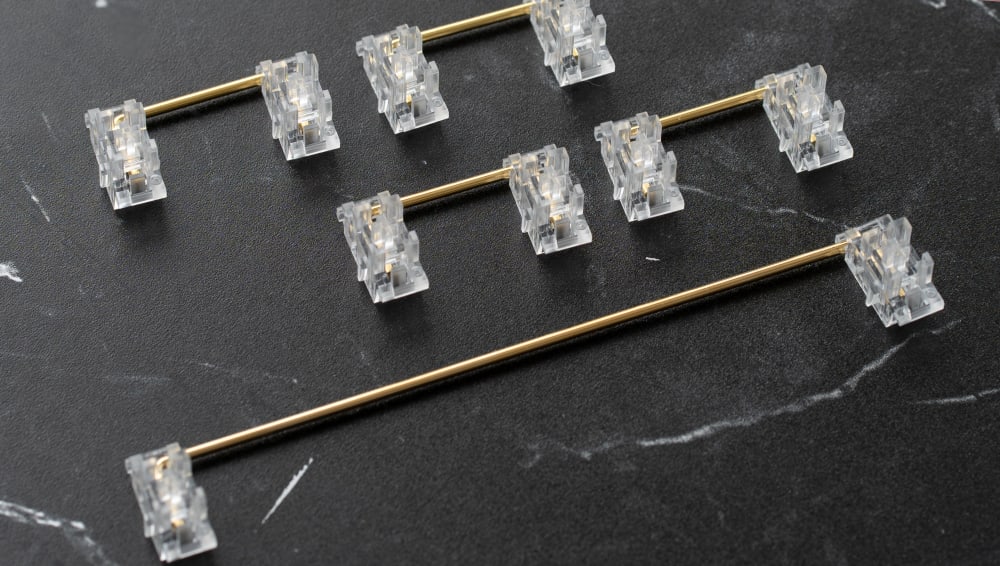

Durock Plate Mount Stabilizers
Stabilizers, or stabs for short, are keyboard parts that are installed in conjunction with mechanical switches to support the largest keycaps of your mechanical keyboard. Mainly spacebar, backspace, enter, left and right shifts depending on your keyboard layout—these keycaps are called modifiers to go along with the alphas on your keyboards.
Whether it’s a custom mechanical keyboard kit or a prebuilt mechanical keyboard, there are two styles of mounting Cherry stabilizers in mechanical keyboards: they can be mounted to your keyboard plate or your keyboard PCB.
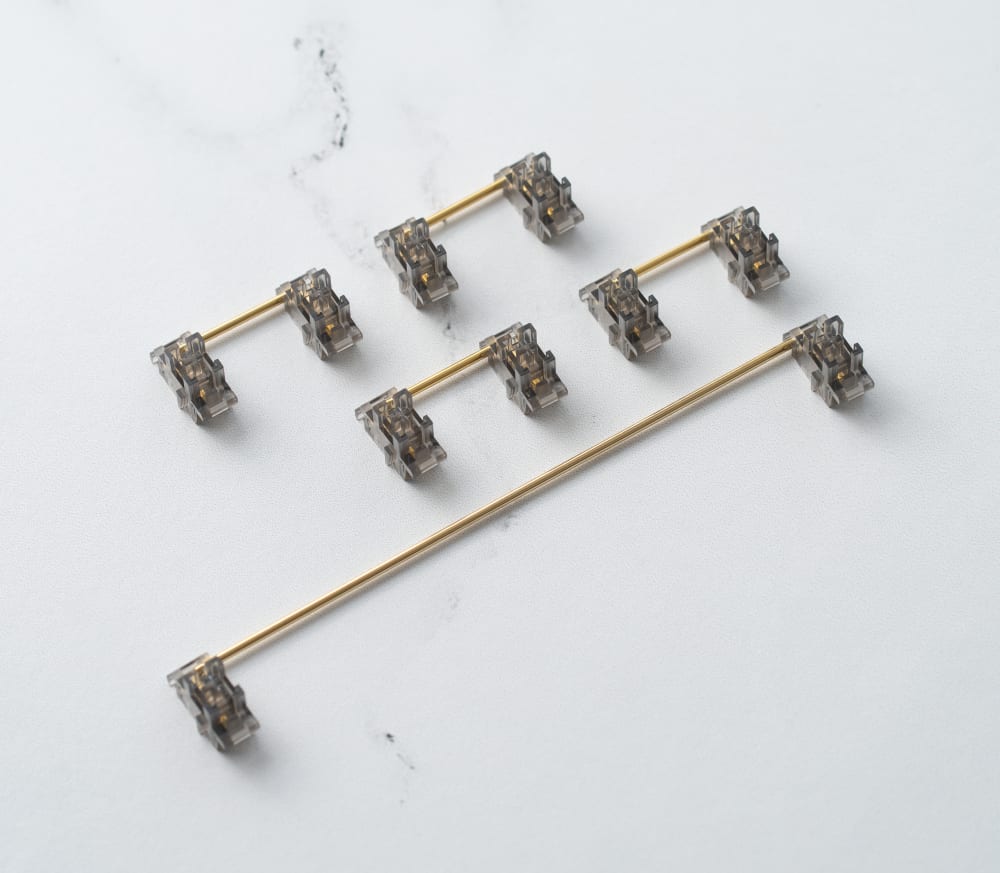

Durock Plate Mount Stabilizers
For the purpose of this article, I’m only going to discuss Cherry-styled stabilizers for Cherry-compatible keycaps and Cherry MX switch-compatible mechanical keyboards. You can find both plate-mount and PCB-mount Durock V2 stabilizers in the Keyboard Accessories section of the Kinetic Labs shop.
You can rarely go without stabilizers unless you are building a keyboard with modifiers that are smaller than 2U—U stands for Unit. The smallest Unit size for a keycap is 1U which is the standard size for alphas like A or W of the number row. Modifiers can range from 1U to 7U or even 10U for some spacebars, I’m sure you can imagine how wobbly and impractical 2U and bigger modifiers would be without stabilizers.
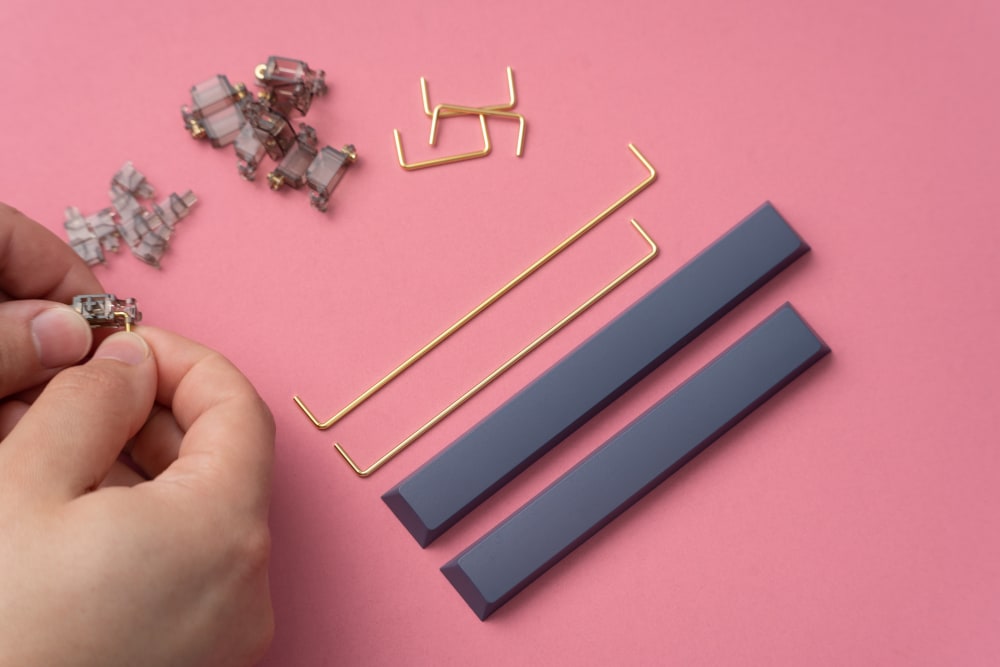

Durock Screw-In Stabilizers
There are those who will tell you that plate-mounted stabilizers don’t produce the same level of performance as PCB-mounted stabilizers—while I don’t disagree entirely, I still disagree. Getting a solid performance from any stabilizers is a finicky process but with some care and the proper mounting technique, the mounting style of your stabilizers isn’t as significant as people might think.
In any case, there are pros and cons to both mounting styles, let’s get to it!
Plate-Mount Stabilizers
Plate-mounted stabilizers look almost the same as PCB-mounted stabilizers, except they don’t have the part that helps fasten them to the PCB but their own mounting style design. The anatomy of a plate-mounted stabilizer consists of a wire, two housings, and two stems. The stems slide into the housings, the wire ends then slide into the stems and get clipped into the housing wire guide to lock the assembly.
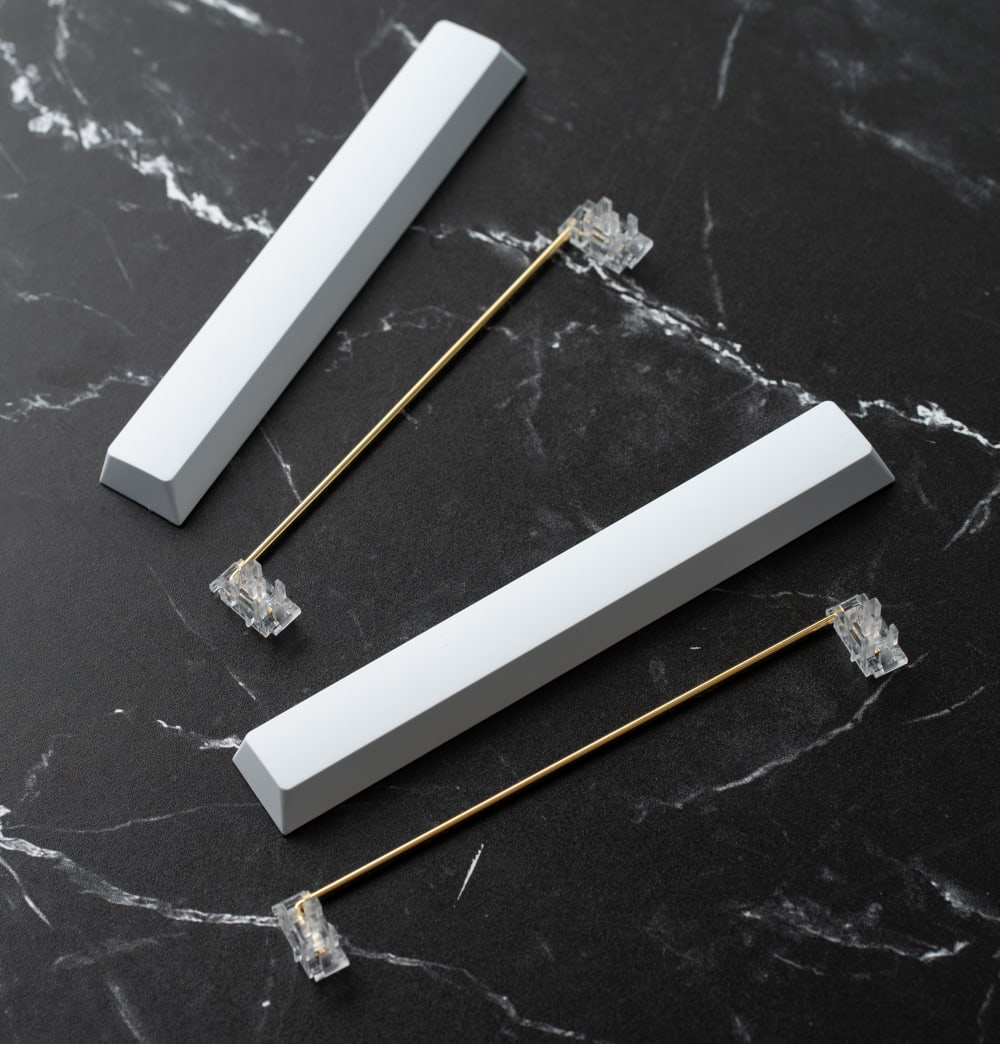

Plate Mount Stabilizer Spacebar Wires
Hot Tip: modifying plate-mount stabs and PCB-mount stabs is the same in terms of lubricants, wire balancing, and mods that can be done to the stems and housings. However, you should consider clipping the stems’ bottom legs that are bent so that the stems lay flat against the PCB once mounted.
This mounting style means that your stabilizers are mounted to the plate in your mechanical keyboard the same way you push in mechanical switches to press-fit them onto your plate. The plate is designed for the stabilizers’ housing to be press-fitted in and stay in place. Plate-mount stabilizers can only fit one way on the plate, but pay attention because sometimes the cut-outs are upside down.
If you look at the side profile of a plate-mount stabilizer housing, you can see a demarcation line along the center of the housing. The bottom part of the housing and the wire fit under the plate while the top part is what you sit atop the plate. On the front of each housing opposite where the wire sits, you have a mechanism that you only have to push in a little to dislodge your plate-mount stabilizers.
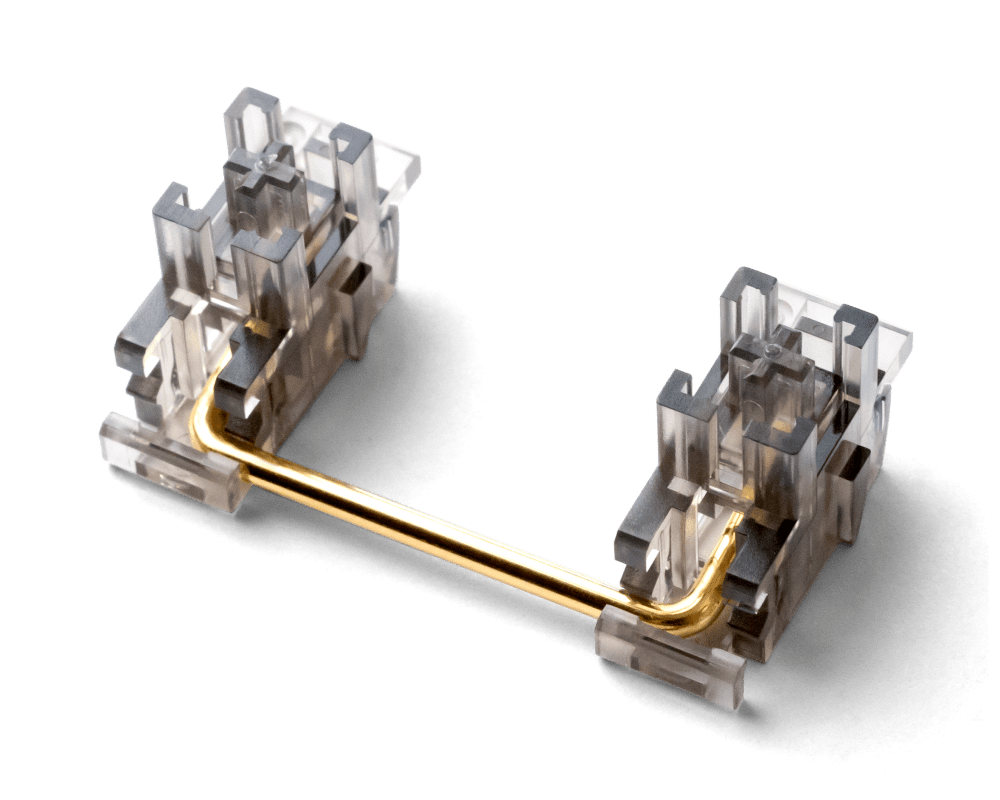

Durock Plate Mount Stabilizers
Hot Tip: pinch your plate-mounted stab housing between your thumb and your index finger and move it side to side—if you can see or feel some play, you have stabilizer wobble which is one of the main causes of stabilizer rattle and ping. The mod that fixes this for plate-mount stabilizers is called a plate ‘tape’ mod. Cut a couple of thin strips of medical tape (the paper kind) and stick one or two to the top or bottom flat edge where you press in your stabilizers. Try moving your stab housings again, your wobble should be gone—be mindful not to add too much tape or you will risk your stabs popping or bulging, and guess what that does…it creates rattle and/or ping.
PCB-Mount Stabilizers
PCB-mount stabilizers have a different anatomy and two different mounting styles compared to plate-mount stabilizers. In terms of parts, you still have a wire, two stems, and two housings which are assembled in the same fashion. PCB-mount stabilizer housings have an extension for mounting that is different from the push-in mechanism on plate-mount stabilizer housings.
With PCB-mount stabilizers, the plate comes to rest on the stabs after they are mounted. Plates are different according to stabilizers’ mounting styles.
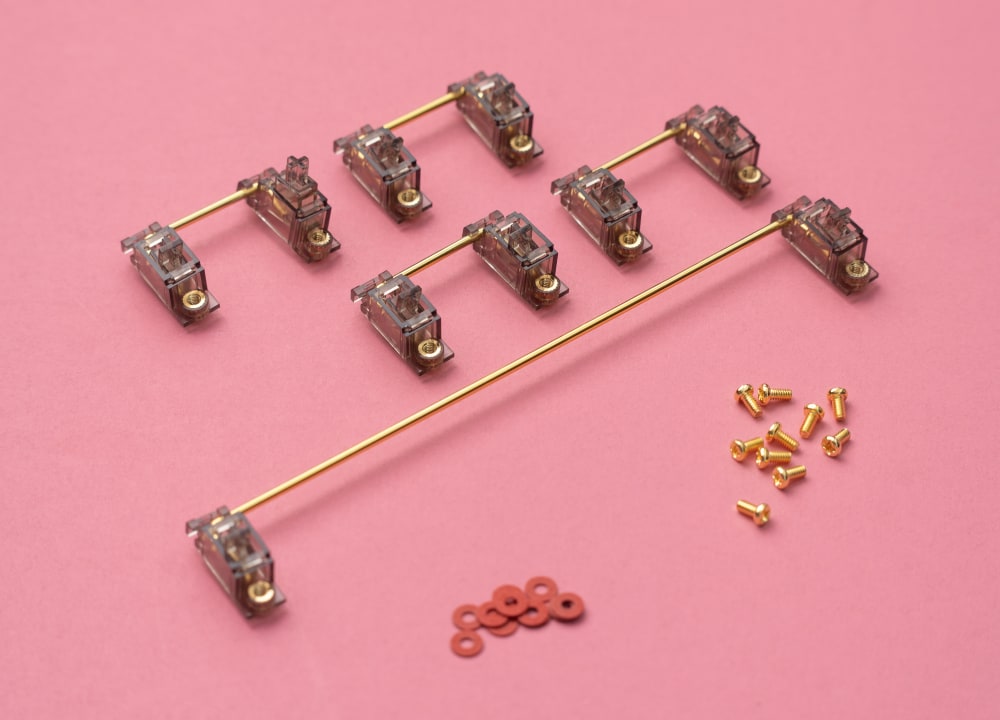

Durock Screw-In Mount Stabilizers
There are two types of PCB-mount stabilizers:
Screw-in Stabilizers
These stabs' housings have a hook at the back of the wire guide and an extension in the front that has a screw-threading insert and they require extra hardware to attach to the PCB. All four stem legs come flat and you have the same size wires in PCB-mount and plate-mount stabilizers.
The hardware consists of washers and screws that go through the PCB to thread into the stabilizer housing. You should always use the washers to make sure the screws are isolated and do not touch any metal threads in the PCB to avoid any electrical shorts.
PCBs are made of layers of copper circuitry in between laminated substrates of non-conductive materials—the holes to screw-in PCB-mount stabilizers are almost always entirely isolated, but better safe than sorry!
Clip-in Stabilizers
These stabs’ housings also have a hook at the back of the wire guide and an extension at the front—a prong with two legs that have retention tabs. On some brands stem legs do not come flat and have to be clipped, on others, all four stem legs are flat. You also get the same wires.
Once assembled, the prong of the housing is pushed through the proper mounting hole in the PCB, effectively clipping in. The legs of the prong press together to fit through the hole then widen underneath it and the retention tabs help avoid the stabilizers from popping out. There are different brands that make clip-in stabilizers but the most recent ones from TX come with their ‘stab stoppers’. These stoppers are pushed between the prongs’ legs to widen the gap and support the retention tabs so the clip-in stabs can’t pop out.
Hot Tip: the older and cheaper Cherry clip-in stabilizers do not come with stoppers. If this is what you have to work with and while doing the housing wobble test you still notice some play, then you can use the toothpick mod. Push a toothpick between the prong legs of your housings to widen the gap and support the retention tabs, then cut the excess.
Both styles of PCB-mount stabs have different mounting styles onto the same PCB cut-outs or holes to which they can only be fastened in one single way no matter the holes’ different orientations. First, you slot the hook at the back of the two stab housings in the larger holes in the PCB and then you press in the front end of the housings in the smaller holes in the PCB.
Hot Tip: according to PCB thickness, you might need to use shims to accommodate for the thickness difference with your average-size stabilizers. Most PCBs are 1.6mm thick but some can be 1.2mm thick. The most common stabilizers are made to fit 1.6mm thick PCBs.
The choice between screw-in and clip-in stabilizers is dependent on keyboard assembly mounting style and on preference. If your keyboard has what’s called o-ring mounting, you most likely will have to use clip-in stabilizers to accommodate the o-ring installed all around between the PCB and plate assembly. If not, and like many things in the world of mechanical keyboards, it’s up to your preference.
Some say that screw-in stabilizers have less housing wobble because you can tighten them better once mounted to the PCB. Some say that screw-in stabs have more stem rattle and wire ticking because they’re made of nylon. Some say clip-in stabs pop out wires or clean off the PCB easily if you pull on tight-fitting keycaps too hard just like you can pull out a switch from a hotswap PCB for the same reason.
Plate-Mount vs. PCB-Mount Stabilizers
You will hear a lot of keyboard enthusiasts tell you that plate-mount stabilizers aren’t as good as PCB-mount stabilizers. Often because plate-mount stabilizers usually come with cheaper costing and prebuilt mechanical keyboards. Plate-mount stabs also come with older mechanical keyboards that aren’t following the most recent trends in mechanical keyboard design.
Both mounting styles of stabilizers allow for easy plugging with lube if need be by using a syringe. But unless you are prepared to take apart your entire keyboard and you are using a hotswap PCB, doing more involved maintenance or swapping your stabs entirely can be difficult. With a soldered PCB, you will have to desolder your entire board to replace your PCB-mount stabilizers whereas you can just unclip your plate-mount stabilizers, and put them back in or swap them easily. Same if you pop a wire by accident, with a hotswap PCB you can take the switch out to get to your PCB-mount stab wire, but with a soldered PCB, you might have to desolder a switch.
On the other hand, it’s hard to argue that PCB-mount stabilizers have less housing wobble. They are better secured to the keyboard assembly and won’t as easily come off when pulling out keycaps for cleaning or swapping as plate-mount stabs. They also tend to feel more stable and robust, especially when you don’t need to clip the stems' legs. You can pop a two-legged stem and break your stab—I’ve done it before.
That being said, don’t stop yourself from buying the mechanical keyboard kit you want or a prebuilt keyboard you want to modify because of plate-mounted stabilizers. You can tune them and adjust them so they serve you just as well. And don’t let people who can buy more expensive keyboards gatekeep you into thinking that mechanical keyboards which are cheaper or older aren’t good, especially if they come with plate-mount stabilizers.
Mechanical keyboards are a matter of preferences and enthusiasm, not the amount of money you spend. My first mechanical keyboard had plate-mount stabs, it served me just fine and I had a lot of fun modifying it!
FAQs
- What is the difference between plate mount and PCB mount stabilizers?
- The difference is that plate-mount stabilizers hook themselves into the keyboard plate directly while PCB mount stabilizers are installed on the PCB directly, making them more secure but also harder to remove and uninstall.
- What are plate mounted stabilizers?
- Plate mounted stabilizers mount directly into the keyboard plate. In comparison, PCB or screw-in stabilizers mount themselves to the keyboard PCB.
- Can you use screw in stabilizers on a plate mount PCB?
- No, if the keyboard only supports plate-mount stabilizers, you cannot use screw-in PCB mount stabilizers on that keyboard unless it supports both plate-mount and screw-in PCB mount stabilizers.
- What is PCB mount stabilizer?
- A PCB mounted stabilizers hooks into the PCB directly while plate mount stabilizers hook into the plate. Plate mounted stabilizers are easier to remove than PCB mounted stabilizers.
- Are plate mounted stabilizers good?
- Yes, plate-mounted stabilizers can be a great choice especially if they have been properly tuned with a keyboard lube such as Krytox 205g0.
- Are plate mount or screw in stabs better?
- Ultimately it will come down to preference and minute differences. In theory, PCB mounted stabilizers will be more stable than plate mounted stabilizers as they adhere to the PCB directly. The plate material can make a difference as well.
- What does plate mounted mean?
- Plate mounted stabilizers mount directly into the keyboard plate. In comparison, PCB or screw-in stabilizers mount themselves to the keyboard PCB.
- What is plate in PCB?
- A plate is the layer on top of the PCB which gives support to the switches, especially on hotswap keyboards. For soldered keyboards, plates may be optional as long as the case supports a plate-less build.